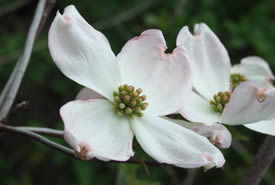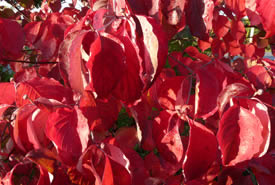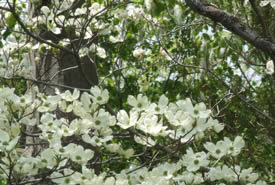
Flowering dogwood (Photo by Bernt Solymar)
Flowering dogwood
Flowering dogwood is well known for its four large, symmetrical, flower-like white leaves that surround a cluster of tiny yellow flowers. In the fall, it has bright red berries that grow in clusters.
Flowering dogwood is a small tree that grows three to 10 metres tall. The bark of larger dogwoods is brownish-grey and scale-like, with the appearance of alligator skin. It is an understory species.
Where is this species found?
In Canada, flowering dogwood only occurs in extreme southwestern Ontario in the Carolinian forest region (click here to see its range).
The species commonly grows in floodplains, slopes, ravines, and it is sometimes found along roadsides.
What is the species’ ecological role?

Fall flowering dogwood (Photo by Bernt Solymar)
More than 50 species of birds feed on the berries of flowering dogwood in the Backus Woods of Ontario alone. The flowers are visited by many pollinating insects. This makes flowering dogwood a very important tree for wildlife.
As an understory tree, flowering dogwood provides cover for many forest animals, and also protects species at forest edges.
What is the species’ conservation status?
Flowering dogwood is currently listed as endangered in Ontario and Canada.
The primary threat to flowering dogwood is the dogwood anthracnose fungus. This non-native fungus was first detected in Ontario in 1998. It attacks the leaves of the tree first, later spreading throughout the twigs and trunk. Infected trees have a mortality rate ranging from 25 to 75 per cent, with the fungus having devastating effects on the population.
Other threats include habitat loss and fragmentation (when habitat is broken into smaller segments).

Flowering dogwood (Photo by Bernt Solymar)
What is NCC doing to protect habitat for this species?
In 2010, the Nature Conservancy of Canada (NCC), with the support of the Weston Family Foundation, successfully conserved Backus Woods — 1,740 hectares (4,300 acres) of land containing old-growth Carolinian forest. The property shelters a number of at-risk species and some of the oldest living trees in Ontario.
NCC is monitoring populations of flowering dogwood on Backus Woods and other properties, in addition to restoring and connecting forested habitats and managing invasive species.





